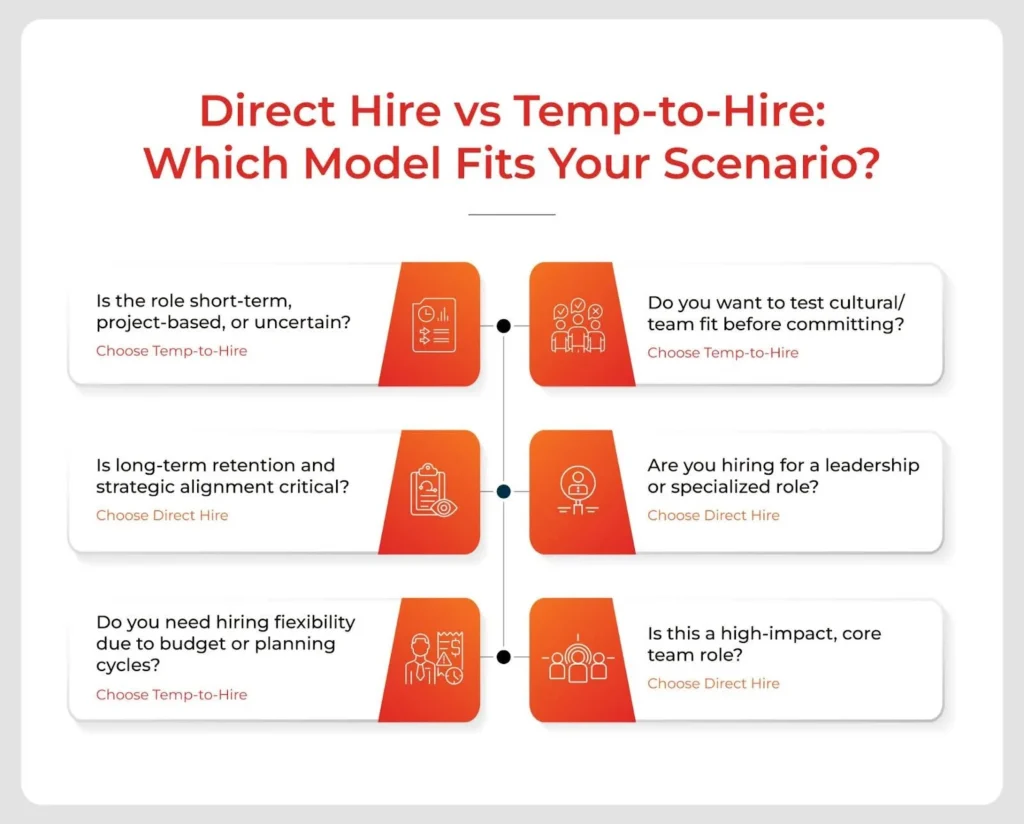Direct hire brings a candidate on board as a full-time employee with benefits, stability, and long-term intent baked in. It’s a commitment from day one.
Temp-to-hire, by contrast, begins with a trial period, typically via a staffing agency, where both parties get a chance to evaluate fit. Only after that do you decide whether to convert the hire into a permanent team member.
Hiring today requires balancing flexibility with foresight, managing costs without compromising on quality, and closing short-term gaps without losing sight of long-term goals.
For many HR and talent acquisition leaders, the question has gone beyond how to hire. They must now figure out which model gets the best return on their investment. Among various hiring models, the direct hire and temp-to-hire models are fairly popular.
The solution lies in the numbers, the outcomes, and the long-term strategy. That’s how you evaluate ROI in the direct hire vs temp-to-hire debate.
Direct Hire vs Temp-to-Hire: What’s the Real Difference?
Let’s begin with the basics to understand the fundamental investment mindset behind each approach.
What does direct hire mean?
You onboard a candidate as a full-time employee right from the first day. There’s no “trial” period, even if going through an external staffing agency. You’re betting long-term (through salary, benefits, onboarding resources, and training) on that hire.
Learn more in our ultimate guide to direct hiring
What does temp to hire mean?
A candidate is initially brought in as a contractor (often via a staffing agency). After a set evaluation period, you decide whether to convert them to full-time. Think of it as a “test drive” before you buy in.
So the real question is whether it is more cost-effective to rent or to own talent?
Cost structures: Upfront spend vs. pay-as-you-go
From a budgeting standpoint, direct hire and temp-to-hire models behave very differently.
- Recruiting fees (if using a staffing agency)
- Onboarding costs: training, equipment, setup
- Benefits package: health, retirement, paid time off
- Severance or replacement cost if the hire doesn’t work out
The full-time offer is an all-in investment. And yes, it pays off if the hire stays.
Temp-to-hire costs:
- Hourly rate or markup fees paid to the staffing agency
- No benefits obligation during the trial period
- Minimal onboarding until conversion
- Conversion fee upon full-time hiring (in many cases)
In short: You are paying for the whole meal upfront in direct hire, while temp-to-hire is ordering à la carte, until you know the entrée is worth it.
Role fit and flexibility: What’s the hiring horizon?
Speed matters. But speed-to-fill and speed-to-productivity aren’t the same thing.
Direct hire often takes longer to close because employers are looking for a “perfect fit.” Once hired, these employees usually onboard faster, thanks to stronger employer branding and long-term alignment from the start.
Temp-to-hire, by contrast, moves faster in terms of offer turnaround, especially with the help of flexible staffing services. But here’s the trade-off: temp workers often delay full engagement until they’re assured of long-term employment. That hesitation can slow early productivity.
So when time-to-productivity matters more than just speed-to-fill, direct hire may produce a more substantial ROI, especially for critical or strategic roles.
Also read: How to choose the best direct hire staffing agency
Evaluating ROI Of Both Models: What Really Impacts Cost and Value?
Time-to-productivity: How fast do they ramp up?
Let’s get one thing straight: turnover is an HR metric and also a P&L problem.
- Direct hire retention is typically higher because employees receive full benefits, a stronger culture experience, and long-term growth paths.
- Temp-to-hire retention depends heavily on conversion. If the path to full-time is unclear or delayed, top talent may walk away, taking your ramp-up investment with them.
But here’s where temp-to-hire shines in risk mitigation:
- You can assess soft skills, team fit, and adaptability before committing
- You reduce exposure to bad hires, which can cost 30% or more of annual salary, per U.S. Department of Labor estimates
Think of it as a trial partnership: lower upfront risk, but often slower to build trust and long-term alignment.
Retention and risk: Will the hire stick?
Not all roles are created equal, and neither should your hiring model be.
Direct hire wins when:
- The role is highly specialized, strategic, or client-facing
- Employer branding and loyalty are part of the value equation
- Long-term skill development is a priority
Temp-to-hire works best when:
- You’re unsure of long-term budget approval
- There’s an internal debate on headcount needs
- You want to test a candidate in a dynamic or ambiguous role
Let’s say you’re hiring a CRM Manager during a Salesforce transition. You may not know if this role will evolve into something bigger or dissolve after implementation. A temp-to-hire solution offers agility without locking in headcount too soon.
But if you’re expanding your core engineering team with senior architects, that’s a direct hire decision because long-term impact deserves long-term commitment.
The Role of a Staffing Agency in Either Model
Here’s what often gets overlooked: both direct hire and temp-to-hire can be managed through a staffing agency. The model you choose doesn’t change the need for a trusted partner who:
- Knows your industry and job market dynamics
- Can access both active and passive talent pools
- Supports pre-vetting, interview scheduling, and compliance
- Helps structure contracts, conversions, and retention plans
With the right direct hire staffing services, employers can reduce time-to-fill without compromising quality. Similarly, with strong temporary staffing solutions, you gain control without adding complexity.
Instead of treating a staffing agency as a vendor. Treat them as a decision partner, someone who helps you make the right call, not just fill the seat.
So… Which Model Offers Better ROI?

Apart from math, ROI is also about alignment. You’ll get better ROI from whichever model is aligned to:
- The role’s criticality
- Your organization’s risk appetite
- Budget flexibility and timeline constraints
- Internal capacity for onboarding and coaching
A temp-to-hire model might win for seasonal or uncertain demand, but direct hire typically delivers stronger ROI for core teams, culture-critical roles, and long-term growth planning.
Still unsure? Consider piloting both models across departments, then track metrics like retention rate, time-to-productivity, and turnover cost. Let data drive the decision.
Final Take: Make Hiring a Strategic Investment Instead Of a Tactical Fix
Hiring is a capital allocation decision. Choosing between a direct hire and a temp-to-hire model requires understanding which one best serves your business at this moment and for this specific role.
Need flexibility? Go temp-to-hire.
Need depth and alignment? Go direct.
Just don’t fly blind. Partner with a staffing agency that helps you weigh the costs, risks, and returns, like a CFO would. Because at the end of the day, your workforce is your investment portfolio.
By carefully evaluating the costs, ROI, and workforce flexibility each model offers, you can make a hiring decision that aligns with both your short-term needs and long-term strategy. SPECTRAFORCE can help you assess your requirements and choose the hiring model that best supports your business objectives.
FAQs
The main difference between direct hire and temp-to-hire lies in the initial employment structure. Direct hire brings the employee on as a permanent member of the team from day one. Temp-to-hire, by contrast, starts with a provisional period, where both parties assess fit before transitioning to a long-term role.
Retention is generally better with direct hire because candidates commit from the outset, often receiving stronger onboarding, benefits, and career alignment. Temp-to-hire can lead to solid long-term placements, but unless the conversion timeline is clear, uncertainty can cause top talent to exit before they ever fully settle.
You should use temp-to-hire when there’s ambiguity in the role, uncertainty around budget approvals, or internal misalignment on headcount. It offers a lower-risk way to evaluate performance and fit before you make a full-time offer, especially useful during transitional phases or periods of high volatility.
Direct hire is the best choice when the role is high-impact, strategic, or requires long-term vision. If you’re investing in someone who will lead teams, shape culture, or own mission-critical deliverables, a full-time hire from day one ensures you’re attracting and retaining the right level of commitment.
Temp-to-hire employees can absolutely become successful permanent hires and often do, provided there’s clarity, engagement, and a structured path to conversion. When expectations are set early and supported by the right staffing services, temp talent can ramp up quickly and integrate seamlessly.



